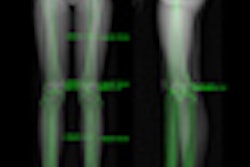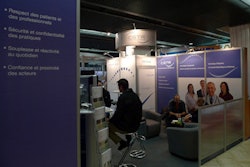
Philips Healthcare is using this week's Medica 2011 show in Düsseldorf, Germany, to launch Sparq, a new mobile ultrasound scanner specifically designed with point-of-care environments in mind. The system includes features that will predominantly be used in four key areas: emergency medicine, regional anaesthesia, critical care, and pain medicine.
 Sparq includes features that address the hygiene requirements of today's hospital environments. All images courtesy of Philips Healthcare.
Sparq includes features that address the hygiene requirements of today's hospital environments. All images courtesy of Philips Healthcare.
The point-of-care market is one of the fastest-growing areas of medicine, outstripping traditional health markets with 12% growth between the years of 2008 to 2010, according to industry sources. In tandem, adoption of ultrasound in point-of-care practice continues to grow rapidly due to societal and national recommendations for ultrasound-guided procedures as efficiency and patient safety is increasingly put first.
Although many mobile ultrasound units boast various combinations of the features included in the Philips system, Sparq's easy-to-clean glass-sealed buttonless touch panel, which reduces risk of transmission of infection between scanned patients, is unique in the ultrasound market, according to the vendor. The control panel includes a one-touch autoscan function that helps even novice Sparq users navigate the most common scan procedures, and also automation that will continuously adjust the scanning in progress to retain image quality without the need for the user to manually modify parameters.
 Sparq is equipped with a sealed glass surface that can be easily disinfected, making it optimally suited for use in sensitive areas with a high hygienic demand.
Sparq is equipped with a sealed glass surface that can be easily disinfected, making it optimally suited for use in sensitive areas with a high hygienic demand.
"The faster, safer workflow created by ultrasound can be further enhanced by cutting down on time spent at the controls before and during the scan," said François Boscheron, international market manager for the point-of-care ultrasound business at Philips.
Ultrasound guidance is widely accepted as positively impacting procedures such as venous line or catheter placement, targeted drug delivery, and assessment and follow-up monitoring of a patient's condition in intensive care units. In addition, ultrasound needle guidance for regional anesthesia not only speeds up the process but also reduces the risk of complications such as hematoma and other injuries arising from hitting vessels or nerves, a more likely occurrence during "blind" procedures.
With accurate needle visualization therefore crucial to patient safety, Sparq joins the ranks of ultrasound scanners that have such needle visualization and target distance estimation features, without any trade-off in image quality, according to Boscheron.
 The Sparq ultrasound system supports precision needle insertion during a lumbar puncture procedure.
The Sparq ultrasound system supports precision needle insertion during a lumbar puncture procedure.
"Its compact size and mobility, as well as its large screen on an adjustable arm, make it suitable for emergency room all-purpose soft-tissue and organ scanning, ultrasound-guided interventions or bedside monitoring of critical patient status through echocardiography or lung ultrasound, for example," he said.
The duration of a medical device's battery life is also important in the point-of-care setting, according to Boscheron, because ultrasound systems needed to be ready to use immediately either next to a patient's bed or in the operating room.
"This system can run on its battery for more than 2.5 hours. Current systems' batteries generally last for a maximum of one hour," Boscheron added.
Where Sparq also departs from traditional ultrasound packages is in its offer of a remote service option that facilitates remote maintenance and repair and also allows users to ask questions about procedures or load additional presets, such as those that might be needed for regional anesthesia. Sparq will also generate "quick" reports dedicated to point-of-care imaging studies rather than adapting them from existing traditional templates.
"Point of care needs more than new technology. It needs new thinking. It's not so much the functionality which is 'novel' but the accessibility of the functions through a user-friendly interface. Sparq has simplified doctors' experience of ultrasound so that they can focus on patients rather than the system," Boscheron said.



















